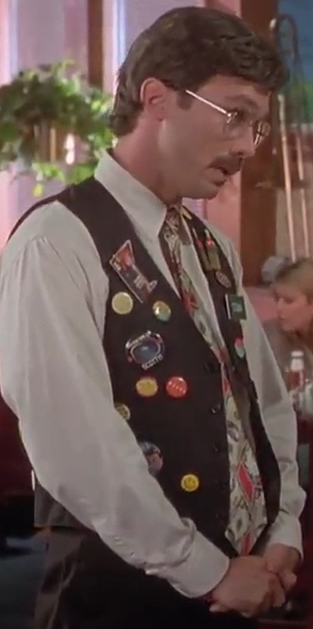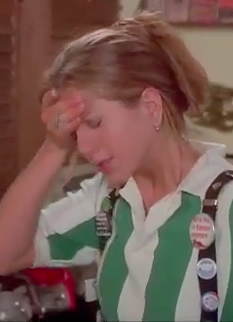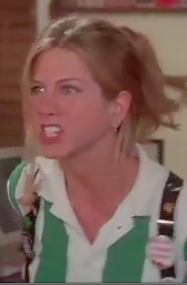UNIT OPENER: Comments and Analysis
|
1. When the manager approaches the waitress, the way he bends and babbles his head, clasps his hands, and makes direct eye contact indicate that he has something serious (and not positive) to say. Subsequently he opens his eyes wide and moves his head from side to side when asking a question. This gives the impression of "here we go again" and perhaps "as we all know". When Joanna flips him the finger, Dan holds up his hands, as if to ward off the gesture. His body language during the conversation, with his head bowed and arms grasped, gives the impression of being casual but solicitous: he's only there to offer helpful, common sense suggestions, as he has done in the past. 2. How about the body language of Joanna, the waitress (Jennifer Aniston)?
3. What's the relationship between the body language and what's said? Dan occasionally uses his hands to accompany what he has to say, as a way to emphasize the points he is making. This kind of gesture is 4. What's the role of dress at Chotchke's restaurant? The restaurant requires servers to wear uniforms but also to wear "flair", buttons with cutsie messages. The message this is intended to send to the customers is that Chotchke's is a fun, friendly place. In theory the flair is supposed to allow the servers to express their individual personalities, but since it is a job requirement, it's a forced, artificial individualism. In practice, how people dress and groom themselves is a form of self-expression, but it can also be something that's culturally and socially determined. If you belong to a motorcycle gang, for example, you are likely to wear black leather and may have tattoos and piercings. If you are a Japanese business man ("salaryman"), you wear a dark suit with a conservative tie, with your hair nicely groomed. In either case, the dress and appearance send a message about that person's identify and provide an interlocuteur information that would help guide the conversation in terms of initial attitude towards the other person, use of language, topics of conversation etc. 5. Is the body language used here universal across cultures? Both Dan and Joanne make what are largely unconscious movements during the conversation, Dan, for example, adjusting his glasses, and Joanna smoothing her hair. These are called "adaptors", involuntary actions, and tend to be similar across cultures. The same is largely true of facial expressions. However, hand and arm gestures tend to vary significantly across cultures. Although the raised middle finger is recognized in many cultures, for example, there are lots of other ways to express insults and obscenities. |
What's the point of this unit's opener?
This unit deals with non-verbal communication, something which can take many forms, including hand and arm gestures (emblems, illustrators), facial expressions (affects display), and vocal effects (paralanguage). Even how people are dressed sends a message. Often non-verbal signals go together and reinforce verbal messages. Sometimes, however, they point in the opposite direction. When Joanna puts her hand to her forehead she is not indicating she is thinking about how to respond but rather the opposite, that the question is ridiculous. Being aware of differences in non-verbal codes among cultures is an important component of intercultural communication competence.
 What messages are sent by the restaurant manager's body language?
What messages are sent by the restaurant manager's body language? When she initially turns to Dan to respond, her eyes are closed and she takes a deep breathe, as if to say "not this again" or "give me patience, Lord". She then makes direct eye contact with him, her eyes opening wide in mock surprise. She then turns away, and continues to fill water glasses, clearly not pleased with the topic of the conversation. When she turns back again, the puts her hand to her forehead, mockingly indicating that she's thinking hard to answer his question, She then looks directly at Dan, points to "pretty boy, Brian" and gives her response. Her body language during the exchange gives a clear indication that she is at the end of her patience with this topic (and this job). Then she moves back a step and proceeds to "express herself", giving the finger not only to Dan but waving it around for others to see as well. The raised middle finger is an "emblem", a gesture that by itself has a very
When she initially turns to Dan to respond, her eyes are closed and she takes a deep breathe, as if to say "not this again" or "give me patience, Lord". She then makes direct eye contact with him, her eyes opening wide in mock surprise. She then turns away, and continues to fill water glasses, clearly not pleased with the topic of the conversation. When she turns back again, the puts her hand to her forehead, mockingly indicating that she's thinking hard to answer his question, She then looks directly at Dan, points to "pretty boy, Brian" and gives her response. Her body language during the exchange gives a clear indication that she is at the end of her patience with this topic (and this job). Then she moves back a step and proceeds to "express herself", giving the finger not only to Dan but waving it around for others to see as well. The raised middle finger is an "emblem", a gesture that by itself has a very clear meaning, without the need for any speech to accompany it. After she throws down her towel, her facial expression (called an "affects display"), an intense stare with bared teeth manifests her anger and hostility.
clear meaning, without the need for any speech to accompany it. After she throws down her towel, her facial expression (called an "affects display"), an intense stare with bared teeth manifests her anger and hostility. called an "illustrator", often used to accentuate what's being said. To add emphasis to his criticism of Joanna he punctuates each word of "...doing the bare minimum" with a toss of his head. During the conversation Joanna sighs several times: this kind of "paralanguage" (tone of voice, vocalization) sends a message - in this case that her patience is being tried.
called an "illustrator", often used to accentuate what's being said. To add emphasis to his criticism of Joanna he punctuates each word of "...doing the bare minimum" with a toss of his head. During the conversation Joanna sighs several times: this kind of "paralanguage" (tone of voice, vocalization) sends a message - in this case that her patience is being tried.